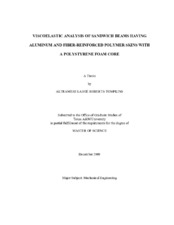| dc.description.abstract | Sandwich beams are composite systems having high stiffness-to-weight and
strength-to-weight ratios and are used as light weight load bearing components. The use
of thin, strong skin sheets adhered to thicker, lightweight core materials has allowed
industry to build strong, stiff, light, and durable structures. Due to the use of viscoelastic
polymer constituents, sandwich beams can exhibit time-dependent behavior. This study
examines and predicts the time-dependent behavior of sandwich beams driven by the
viscoelastic foam core. Governing equations of the deformation of viscoelastic materials
are often represented in differential form or hereditary integral form. A single integral
constitutive equation is used to model linear viscoelastic materials by means of the
Boltzmann superposition principle. Based on the strength of materials approach, the
analytical solution for the deformation in a viscoelastic sandwich beam is determined
based on the application of the Correspondence Principle and Laplace transform. Finite
element (FE) method is used to analyze the overall transient responses of the sandwich
systems subject to a concentrated point load at the midspan of the beam. A 2D plane
strain element is used to generate meshes of the three-point bending beam. User material (UMAT) subroutine in ABAQUS FE code is utilized to incorporate the viscoelastic
constitutive model for the foam core. Analytical models and experimental data available
in the literature are used to verify the results obtained from the FE analysis. The stress,
strain, and deformation fields during creep responses are analyzed. Parameters such as
the viscosity of the foam core, the ratio of the skin and core thicknesses, the ratio of the
skin and core moduli, and adhesive layers are varied and their effect on the timedependent
behavior of the sandwich system is examined. | en |


